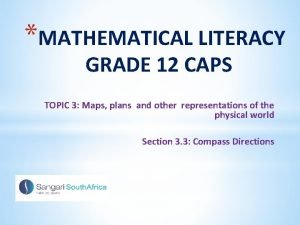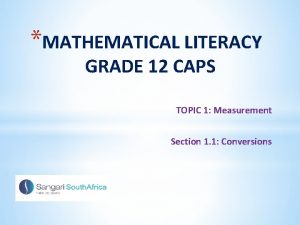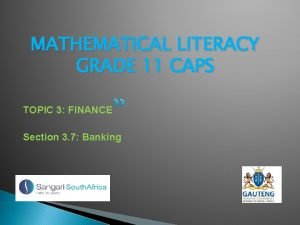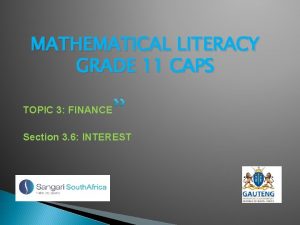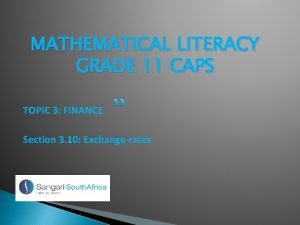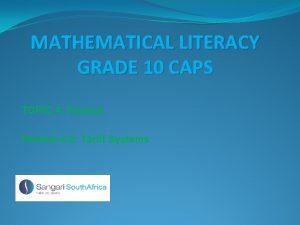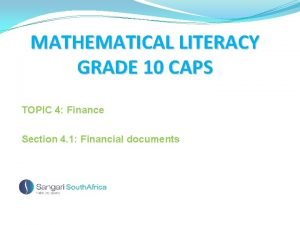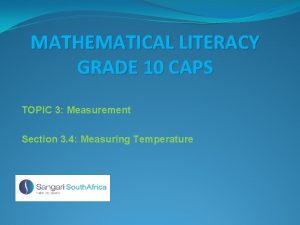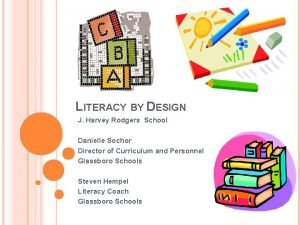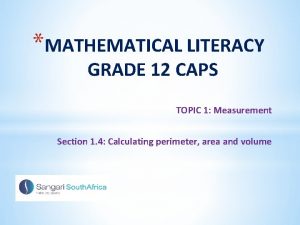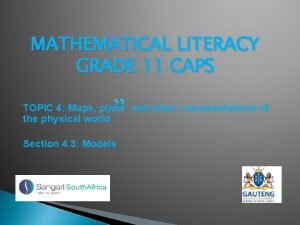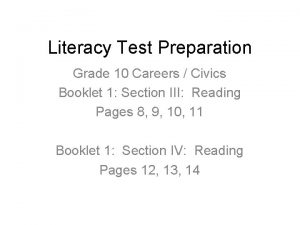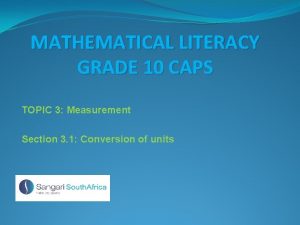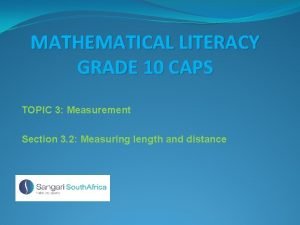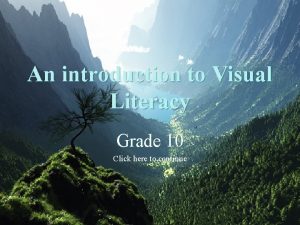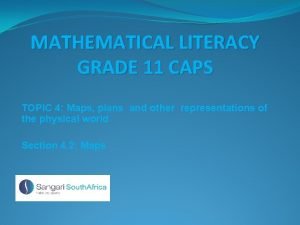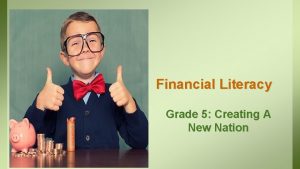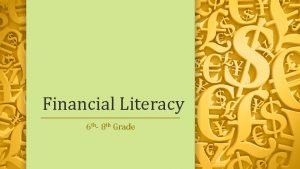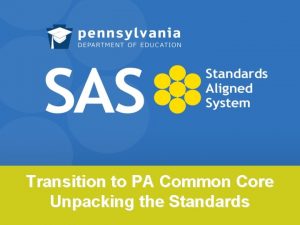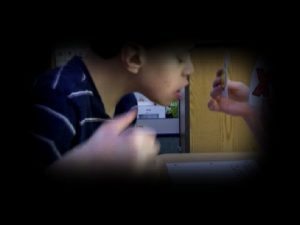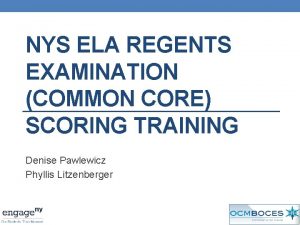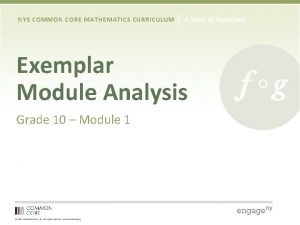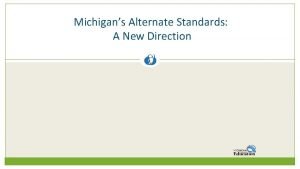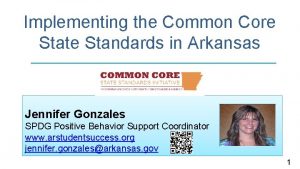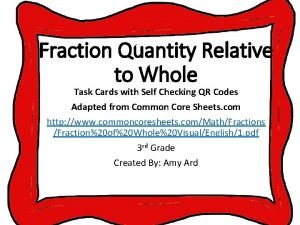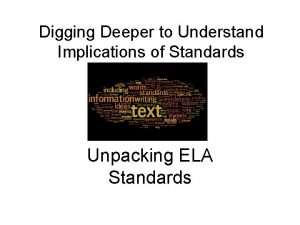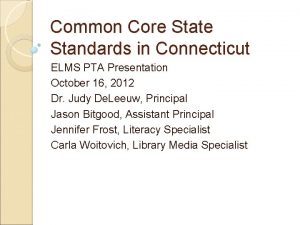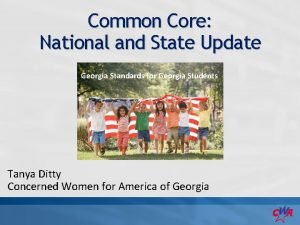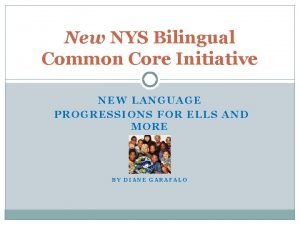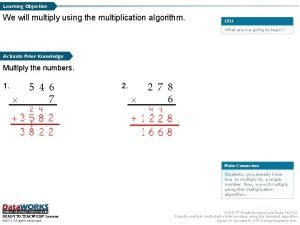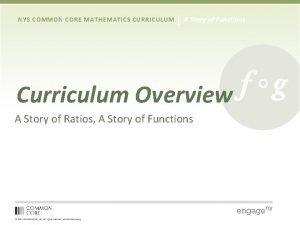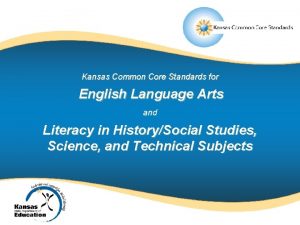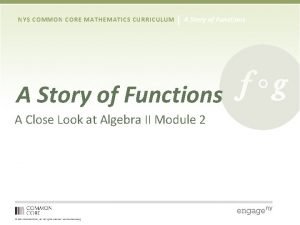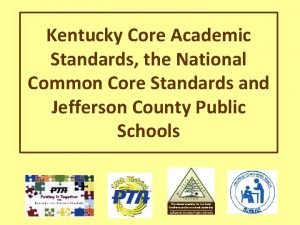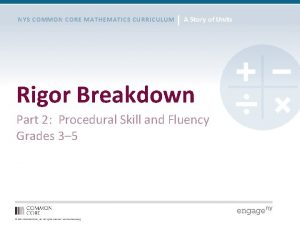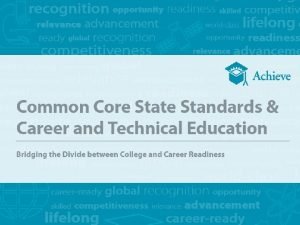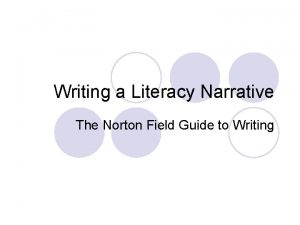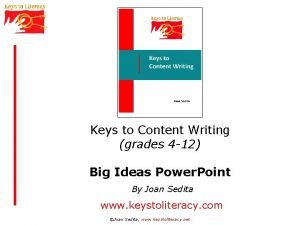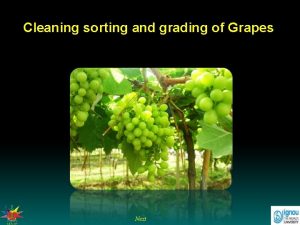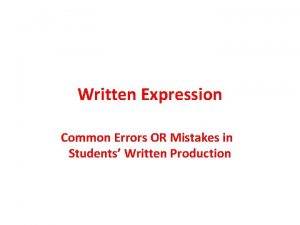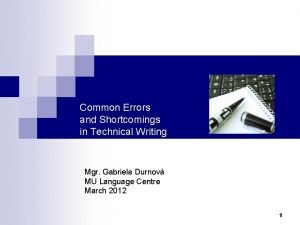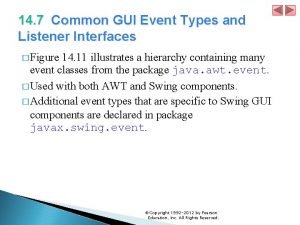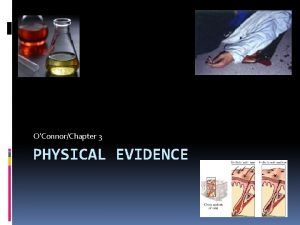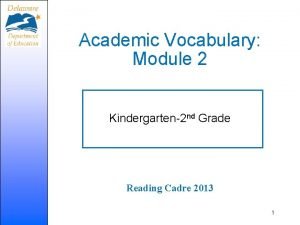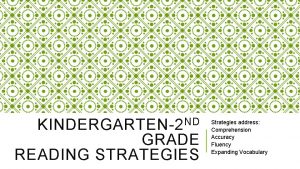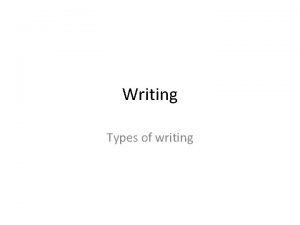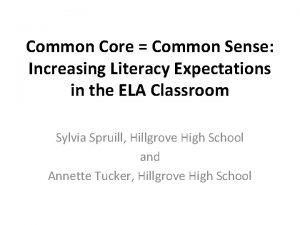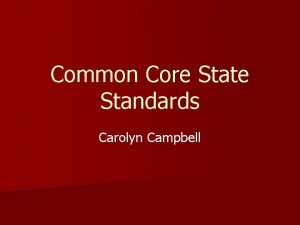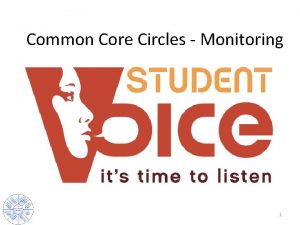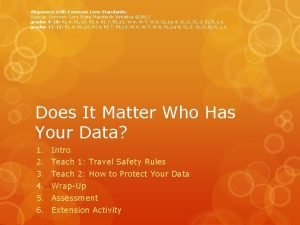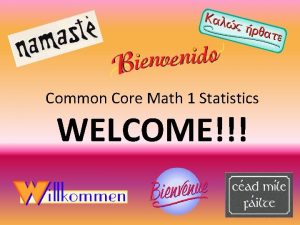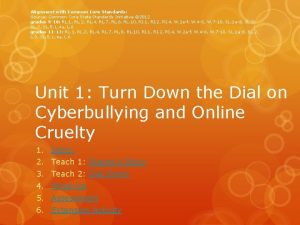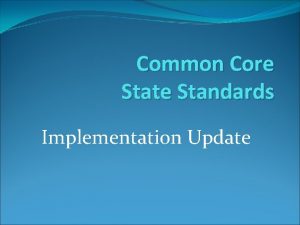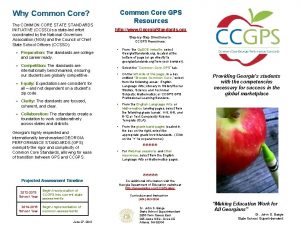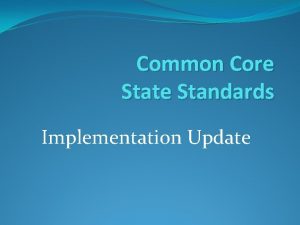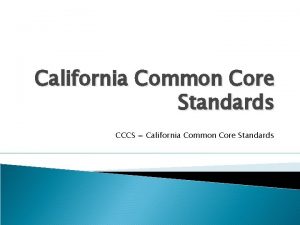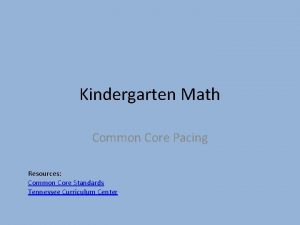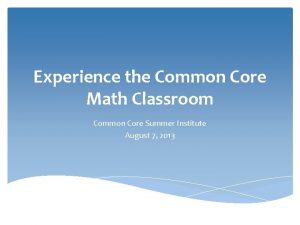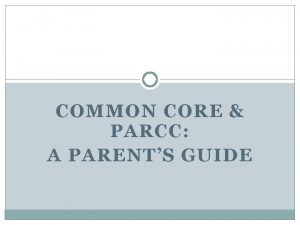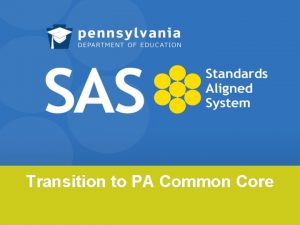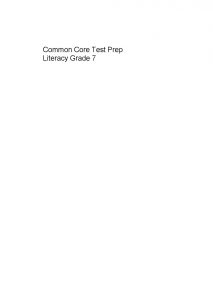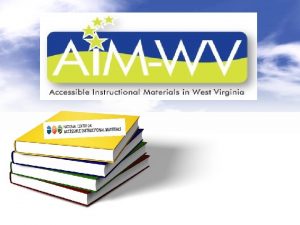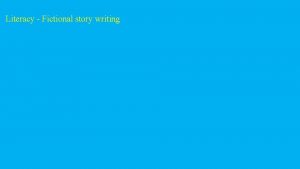Common Core Writing Types Kindergarten2 nd Grade Literacy








































































- Slides: 72

Common Core Writing Types Kindergarten-2 nd Grade Literacy Cadre 2016 1

Activating Strategy Name the Standards 1. Work with a partner. 2. Read the Writing Anchor Standards (pg. 18), and “name” the standard with a 1 -5 word phrase (ex. Reading #1=Evidence) 3. Record on sheet in packet 4. Discuss with whole group 5. Repeat process with: Writing Standards, pg. 18 2

Expected Outcomes • Familiarity with writing standards • Understanding of each writing type – Opinion/Argument – Informative/Explanatory – Narrative • Identifying core descriptors that define each writing type • Identifying how expectations change across grade levels 3

Essential Questions • Why is it important to know core descriptors? • How will knowing the core descriptors impact classroom instruction for all learners? • Why is it important to know the expectations across primary grade levels? 4

The Writing Process 5

Pre. Writing • • • Brainstorming/Making Lists Mentor Texts Quick Writes Graphic Organizers Conducting Research 6

Writing • Draft • Writing stamina 7

Revising • Suggestions for “sentence level” revision/teaching grammar in context • Using a first or second draft of a paper… – Highlight all of the “to be” verbs in the paper and try to eliminate half of them. – Highlight the first two or three words of each sentence. If they are repetitive, change one or more. – Look at your sentence length. If all sentences are short/simple, combine some to form complex sentences. 8

Editing • Grammar and spelling • Peer editing/Clocking 9

Publishing • Author’s Chair • Make a book or display • Make a gift for a friend 10

Writing Standard 1 Grades K-2 College and Career Readiness (CCR) Anchor Writing Standard (1): Write arguments to support claim(s) in an analysis of substantive topics or texts, using valid reasoning and relevant and sufficient evidence. Grade K: Grade 1: Grade 2: Use a combination of drawing, dictating, and writing to compose opinion pieces in which they tell a reader the topic or the name of the book they are writing about and state an opinion or preference about the topic or book (e. g. , My favorite book is…). Write opinion pieces in which they introduce the topic or name the book they are writing about, state an opinion, supply a reason for the opinion, and provide some sense of closure. Write opinion pieces in which they introduce the topic or book they are writing about, state an opinion, supply reasons that support the opinion, use linking words (e. g. , because, and, also) to connect opinion and reasons, and provide a concluding statement or section. 11

Learning Progression Grade K Standard 1 Progression to Mastery With prompting and support… Identify the title of a book or topic to write about Tell about a topic or name a book Recognize what an opinion is State an opinion or preference about a book or topic Combine drawing, dictating and writing to create an opinion piece Support the opinion or preference with reason(s), example(s), and/or fact(s) Use a combination of drawing, dictating, and writing to compose opinion pieces in which they tell a reader the topic or the name of the book they are writing about and state an opinion or preference about the topic or book Key Concepts Guiding Prompts Opinion Topic(s) Book title(s) Reason(s) Example(s)/fact(s) Evidence/Support What is the name of the book? What is the topic? What do you think about the topic/ or, what do you think about the book? Why do you think this? What picture can you draw to show your opinion? What can you say about your picture? What title can you give your picture? 12

Learning Progression Grade 1 Standard 1 Progression to Mastery State an opinion or preference about a book or topic Use teacher selected resources to locate and choose facts and/or examples Differentiate between important and unimportant reasons Identify & demonstrate effective introductions (one that includes the writer’s opinion/hook) Organize writing with a logical beginning, middle and end Identify & demonstrate effective closure Write opinion pieces in which they introduce the topic or name the book they are writing about, state an opinion, supply a reason for the opinion, and provide some sense of closure. Key Concepts Opinion Topic(s) Book title(s) Reason(s) Example(s)/fact(s) Evidence/Support Audience Format Introductions Ending/Closure Organization Guiding Prompts What is the title of the book? What is the topic? What do you think about the topic/ or, what do you think about the book? What is one reason you think this way about the topic? The book? What is the best way to introduce your thinking that will make your reader interested? What words and pictures work best to tell what you think? How can you logically organize your thinking? What is the best way to show you reader you’re finished? 13

Learning Progression Grade 2 Standard 1 Progression to Mastery Choose a topic Form an opinion about a topic or a text Topic(s) Create a list of reasons that support the opinion Book title(s) Choose reasons based on facts, examples, and/or evidence that support the opinion Create an introduction that hooks the reader using an opening technique Opening Techniques (direct statement, personal connection, fact based question, quotation, analogy, fact or detail) Organize writing with a beginning, middle and end Audience Reason(s) Use simple transition/linking words that show order (e. g. , first, next, finally) and/or connect reasons Recognize closure techniques for creating a concluding statement or section Determine a technique that helps the reader consider the key point(s) one more time Organization Example(s)/fact(s) Evidence/Support Linking/transition words Provide a concluding statement or section Write opinion pieces in which they introduce the topic or book they are writing about, state an opinion, supply reasons that support the opinion, use linking words (e. g. , because, and, also) to connect opinion and reasons, and provide a concluding statement or section. Key Concepts Opinion Introduction Guiding Prompts What is the topic? Or, what is the name of the book? What do you think about the topic/ or, what do you think about the book? What is the best way to state you opinion that will make your reader interested? What are two or three reasons you can write to show what you think? Are your reasons relevant? Do they support your opinion? Who are your readers? What are their needs? Have you used linking words such as because and next to connect your opinion to your reasons? Concluding Statement Are your reasons/ideas in order? Techniques for closure (reinforcement, quotation, personal story, question) How can you write an ending sentence or two that provides closure to and restates your opinion? 14

Writing Standard 2 Grades K-2 College and Career Readiness (CCR) Anchor Writing Standard (2): Write informative/explanatory texts to examine a topic and convey complex ideas and information clearly and accurately through the effective selection, organization, and analysis of content. Grade K: Use a combination of drawing, dictating, and writing to compose informative/explanatory texts in which they name what they are writing about and supply some information about the topic. Grade 1: Write informative/ explanatory texts in which they name a topic, supply some facts about the topic, and provide some sense of closure. Grade 2: Write informative/ explanatory texts in which they introduce and a topic, use facts and definitions to develop points, and provide concluding statement or section. 15

Learning Progression Grade K Standard 2 Progression to Mastery With prompting and support… Choose an interesting topic for writing Provide an appropriate title for drawing or writing Draw, dictate, or write information about the topic Select important information to include Use a combination of drawing, dictating, and writing to compose informative/explanatory texts in which they name what they are writing about and supply some information about the topic. Key Concepts Topic Title Details to support Pictures with Labels Facts Important Guiding Prompts What are you drawing or writing about? What would be a good title for your drawing or writing? What two or three things do you most want your reader to know? What picture(s) will you draw to go with your words What details can you add to the picture(s)? Why are you sharing all of this information with your reader? 16

Learning Progression Grade 1 Standard 2 Progression to Mastery Choose an interesting topic for writing Provide an appropriate title for writing Select important details to include Identify and use simple words to show time order (first, next, last) Identify effective introductions and endings/closure Identify and demonstrate effective introductions (one that includes the writer’s topic/hook) Organize writing with a logical beginning, middle and end Write a logical sequence of information on the selected topic Identify and demonstrate effective closure Write informative/explanatory texts in which they name a topic, supply some facts about the topic, and provide some sense of closure Key Concepts Topic(s) Title(s) Details(s) Example(s)/fact(s) Evidence/Support Format Introductions Ending/Closure Organization Important Time order words Guiding Prompts What is the topic? What would be an appropriate title for your writing? What facts will you include? How can you use pictures to add detail? How can you grab your reader’s attention about your topic? How should you order your information? What do you want to say last about your topic to make an interesting ending? 17

Learning Progression Grade 2 Standard 2 Progression to Mastery Choose an interesting topic for writing Provide relevant information (facts and definitions) to elaborate or clarify the subject Write an effective introduction for the topic Determine how to group related information Identify and use simple transition/linking words that show order (e. g. , first, next, finally) Define important words for the reader Provide a concluding statement/section Write informative/explanatory texts in which they introduce a topic, use facts and definitions to develop points, and provide concluding statement or section Key Concepts Topic(s) Reason(s) Example(s) facts/points Evidence/Support Introduction Ending/Closing Organization Transition/linking words Time order words Guiding Prompts What do you want to explain about your topic? What detail/facts will you include to give enough information? Is there an important word you have learned that you can define for your reader? What should you say first, second, and third so that you make a clear point about your topic? What ideas can you adapt from books (pictures with captions, labeled drawings) to help you illustrate your piece? How can you use transition words to show order? When you think about your topic, what do you want to say as a final point or ending? 18

Writing Standard 3 Grades K-2 College and Career Readiness (CCR) Anchor Writing Standard (3): Write narratives to develop real or imagined experiences or events using effective technique, well-chosen details, and well-structured event sequences. Grade K: Use a combination of drawing, dictating, and writing to narrate a single event or several loosely linked events, tell about the events in the order in which they occurred, and provide a reaction to what happened. Grade 1: Write narratives in which they recount two or more appropriately sequenced events, include some details regarding what happened, use temporal words to signal event order, and provide some sense of closure. Grade 2: Write narratives in which they recount a well-elaborated event or short sequence of events, include details to describe actions, thoughts and feelings, use temporal words to signal event order, and provide a sense of closure. 19

Learning Progression Grade K Standard 3 Progression to Mastery Identify an event(s) Draw a picture that tells a story about the event(s) Discuss what has been drawn Identify the who, what and when of the event Describe feelings during the event/series of events Tell a story about several events Draw, write or dictate events in the order they happened Use a combination of drawing, dictating, and writing to narrate a single event or several loosely linked events, tell about the events in the order in which they occurred, and provide a reaction to what happened. Key Concepts Draw Who, What and When Retell Events Order/Sequence Feelings Reaction Guiding Prompts How can you draw, dictate, or write about an event(s)? Do you want to tell about a real event(s) that really happened? Or do you want to make up a story? What happened first? Next? And then? How does it end? What do you think about what happened? Or, what do the characters feel? 20

Learning Progression Grade 1 Standard 3 Progression to Mastery Choose an experience to write about Identify the character and setting Choose two or more events to include in the piece Include relevant details that describe what happened Tell the events in order Choose temporal words that move the story forward Use temporal words in order to signal a change of events (long time ago, today, later, first, next, then, and last) Provide an ending or some sense of closure Write narratives in which they recount two or more appropriately sequenced events, include some details regarding what happened, use temporal words to signal event order, and provide some sense of closure. . Key Concepts Character(s) Setting Order/Sequence Details Event(s) Temporal words Ending/Closure Guiding Prompts Is the story real or made up from your imagination? What happens? And in what order do things happen? Have you added enough details so readers can understand? Have you made it clear how one event leads to another? Have you used temporal words to show the order of the events? How does the story end? 21

Learning Progression Grade 2 Standard 3 Progression to Mastery Choose an experience to write about Identify the character and setting Choose relevant details that describe what happened during the event(s) Include and elaborate on details to describe actions, thoughts and feelings related to the events Identify sequence of event(s) Choose temporal words that move the story forward Use temporal words in order to signal a change of events (long time ago, today, later, first, next, then, and last) Provide a sense of closure Write narratives in which they recount a well-elaborated event or short sequence of events, include details to describe actions, thoughts and feelings, use temporal words to signal event order, and provide a sense of closure Key Concepts Narrative Setting Character(s) Details Descriptive words Event(s)/experience(s) Actions, thoughts and feelings Sequence/time Temporal words Closure Guiding Prompts Is the story real or is it one you made up from your imagination? What happens? What is the main event? And what order do things happen? How can you include details to express an event in order? Have you added enough details that describe people’s actions, thoughts, and feelings? Have you made it clear how one event leads to another? Have you used temporal words to show the order of the events? How does the story end? 22

Progressions in Development and Learning Discuss: What are the stages of writing development? What is a learning progression? 23

Developmental Progressions Pre-phonemic Stage • Random scribbling - The starting point is any place on the page. • Controlled scribbling - Progression is from left to right. • Circular scribbling - Circles or ovals flow on the page. • Drawing - Pictures tell a story or convey a message. • Mock letters – These can be personal or conventional symbols, such as a heart, star, or letters with extra lines. • Letter strings - These move from left to right and progress dawn the page of actual letters. They have no separations and no correlation with words or sounds. • Separated words- Groups of letters have space in between to resemble words. Early Phonemic Stage • Picture labeling - A picture's beginning sound is matched to a letter (Dog. ) • Awareness of environmental print Environmental print, such as names on cubbies, is copied. • Transitional stage spelling or invented spelling - First letter of a word is used to represent the word (I went to the nature museum). Letter-Name Stage • Beginning and ending letters are used to represent a word (cat). 24

Developmental Progression Cont. Transitional Stage • Medial sound is a consonant (grass). • Medial sound is in correct position, but the vowel is wrong (grass). • A child hears beginning, medial, and ending letters (I like to pick flowers). • Writing Phrase writing develops (rabbit in the sun). • Whole-sentence writing develops (This pumpkin is mine). Conventional Writing Stage • Transitional stage spelling (or invented spelling) is replaced by full, correct spelling of words. 25

Common Core Text Types – Opinion/Argument – Informative/Explanatory – Narrative 26

Opinion/Argument Write arguments to support claims in an analysis of substantive topics or texts, using valid reasoning and relevant and sufficient evidence. 27

Pre/Post Assessment Opinion Which kind of pet is best, a cat or dog? Read the story “The best Pet” aloud to students. Then have them write which pet they think is best based on details from the text. 28

Graphic Organizer 29

Opinion Writing Rubric 30

Opinion Writing Rubric 31

Opinion Writing Rubric 32

Writing Rubric Changes Then Now Traits Reading/Research Organization Development Lang. /Conventions Evidence/Elaboration Organization/Purpose Lang. /Conventions Reading/Research & Development = Evidence/Elaboration Weighting Reading/Research – 2 Organization – 2 Development – 3 Lang. /Conventions - 1 Non-Scorable Responses ---- Evidence/Elaboration – 2 Organization/Purpose – 2 Lang/Conventions - 1 Added PL Descriptors 1 -4 Added: Above, At, Approaching, Below PL 4 Approaching next grade level At next grade level 33

Opinion/Argument Scored Sample Organization: 3 Elaboration/Evidence: 3 Language: 3 34

Opinion/Argument Activity Score the 2 nd grade Writing sample using the rubric: The Best Pet http: //achievethecore. org/content/upload/Argument. Opinion_K-12 WS. pdf See attachment 35

Mentor Text Opinion Idea: the text inspires the writer to create an original idea based on one from the text. Structure: the text presents an organizational structure that the writer tries to emulate using original ideas. Written Craft: the author’s writing style, ways with words, or sentence structure inspires the writer to try out these techniques. Public Schools of North Carolina 36

Group Sharing • What are some core descriptors that define this writing type? • How do expectations change over time? 37

Informative/Explanatory Write informative/explanatory texts to examine and convey complex ideas and information clearly and accurately through the effective selection, organization, and analysis of content. 38

Pre/Post Assessment Informative • How does the Lorax feel about the Earth? Read the story “The Lorax” by Dr. Seuss aloud to the class. After you are finished reading have the students answer the question above. 39

Graphic Organizer Spoke for the water Spoke for the trees Save the fruit The Lorax cares about the Earth. The Lorax wanted to save the Earth. 40

Informative Writing Rubric 41

Informative Writing Rubric 42

Informative Writing Rubric 43

Writing Rubric Changes Then Now Traits Reading/Research Organization Development Lang. /Conventions Evidence/Elaboration Organization/Purpose Lang. /Conventions Reading/Research & Development = Evidence/Elaboration Weighting Reading/Research – 2 Organization – 2 Development – 3 Lang. /Conventions - 1 Non-Scorable Responses ---- Evidence/Elaboration – 2 Organization/Purpose – 2 Lang/Conventions - 1 Added PL Descriptors 1 -4 Added: Above, At, Approaching, Below PL 4 Approaching next grade level At next grade level 44

Informative/Explanatory Scored Sample Organization: 3 Evidence: 3 Language; 3 45

Informative/Explanatory Activity Score 2 nd Grade writing sample using Rubric: All about solids and liquids http: //efront. readingandwritingproject. com/public/themes/rwproject/resources/stud ent_writing/second/2013/Information_-_All_About. Solids_and_Liquids_2 nd_grade. pdf See attachment 46

Mentor Text for Informative • Idea: the text inspires the writer to create an original idea based on one from the text. • Structure: the text presents an organizational structure that the writer tries to emulate using original ideas. • Written Craft: the author’s writing style, ways with words, or sentence structure inspires the writer to try out these techniques. Public Schools of North Carolina 47

Group Sharing • What are some core descriptors that define this writing type? • How do expectations change over time? 48

Narrative Write narratives to develop real or imagined experiences or events using effective technique, well-chosen details, and well-structured event sequences. 49

Pre/Post Assessment Describe your most memorable family moment. 50

Narrative Graphic Organizer Lost my food July beach Mom, dad, sister Sat on blanket and took out my sandwich. A bunch of sea gulls started to walk over to me. Sea gull grabbed my sandwich and ate it. 51

Narrative Rubrics 52

Narrative Rubrics 53

Narrative Rubrics 54

Writing Rubric Changes Then Now Traits Reading/Research Organization Development Lang. /Conventions Evidence/Elaboration Organization/Purpose Lang. /Conventions Reading/Research & Development = Evidence/Elaboration Weighting Reading/Research – 2 Organization – 2 Development – 3 Lang. /Conventions - 1 Non-Scorable Responses ---- Evidence/Elaboration – 2 Organization/Purpose – 2 Lang/Conventions - 1 Added PL Descriptors 1 -4 Added: Above, At, Approaching, Below PL 4 Approaching next grade level At next grade level 55

Narrative Scored Sample Organization: 2 Evidence/Elaboration: 3 Language: 3 56

Narrative Activity Score the following K writing piece: Cat Burglar http: //achievethecore. org/content/upload/Narrative_K-12. pdf See attachment 57

Mentor Texts Narrative • Idea: the text inspires the writer to create an original idea based on one from the text. • Structure: the text presents an organizational structure that the writer tries to emulate using original ideas. • Written Craft: the author’s writing style, ways with words, or sentence structure inspires the writer to try out these techniques. Public Schools of North Carolina 58

Group Sharing • What are some core descriptors that define this writing type? • How do expectations change over time? 59

Gradual Release Model There are four components of the GRM: 1. Focus Lesson- establish purpose, brief, and teacher modeling occurs to activate prior/background knowledge 2. Guided Instruction- teacher prompts, facilitates, leads instruction. Student’s needs are addressed. 3. Collaborative Learningopportunities for students to problem solve with peers. Teacher monitors. 4. Independent work- students apply understanding in new ways. 60

Writing Across the Curriculum Writing-to-Learn • Strategies that teachers employ throughout and/or at the end of a lesson to engage students and develop big ideas and concepts • Fosters critical thinking and learning. • Impromptu, short/informal writing tasks designed by the teacher and included throughout the lesson to help students think through key concepts and ideas. • Attention is focused on ideas rather than correctness of style, grammar or spelling. It is less structured than disciplinary writing. Writing-to-Demonstrate-Knowledge • Assignment that teachers employ when they assign reports, essays, persuasive writing letters and papers, and research papers. • Students show what they have learned by synthesizing information and explaining their understanding of concepts and ideas. • Students write for an audience with a specific purpose. • Products may apply knowledge in new ways or academic structures for research and/or formal writing. Think-Pair-Share: How might you use these ideas in your classroom? Be ready to share out. 61

Writing Across the Curriculum Strategies • GIST (Generating Interactions between Schemata and Texts) • • Summarizing text RAFT (Role, Audience, Format, topic) List, group, label Note taking, Marginal notes, Journaling Quick Write, Essay, Report Thinking map Compare/Contrast Concept definition map 62

Writing Lesson Resources and Modeling Resources • Creative Writing Teacher Resources (Grades K-12) - Teacher. Vision. com • Achievethecore. org : : Home • The Reading & Writing Project – Home • • • Write Alouds - Read. Write. Think www. readwritethink. org › Professional Development › Strategy Guides • • Shared Writing - Read. Write. Think www. readwritethink. org › Professional Development › Strategy Guides 63

Accommodations for All Learners • • Build upon students’ strengths, interests, and needs Build in time every day for review of important concepts Make tasks meaningful Use symbols/signals to help students follow directions, i. e. , arrow to continue, stop sign to stop Chunk/highlight key passages using markers or highlighting tape Use clear overlays that won’t ruin the book Allow students to dictate their stories into a tape recorder 64

Students With Disabilities (SWD) Students with disabilities are a heterogeneous group with one common characteristic: the presence of disabling conditions that significantly hinder their abilities to benefit from general education (IDEA 34 CFR§ 300. 39, 2004). For Students with disabilities to be successful they will need: 1. Supports and related services to address their unique educational need 2. An IEP to help them build skills to access the general education curriculum 3. High quality, evidence based, individualized instruction Teacher should: 1. Be familiar with Standards and decide if student needs to master whole standard or parts of the standard 2. Analyze test results and determine students Present Level of Performance (PLEP) and determine how far off grade level the student is working. Be sure to document all data sources used 3. Define the student in terms that translate directly into instructional intervention Lessons designed with Universal Design of Learning Principles will allow the student the most access to grade level standards with minimal to no barriers. 65

Activity Divide group in half. Group A read ‘Recommendations’ 1 and 2 and concluding statement Group B read ‘Recommendations’ 3 and 4 and concluding statement Each group share out their opinion on the piece of the article that they read. Do you find the recommendations to be of value? Would you try or have you tried any of these recommendations in your classroom? Once finished the groups can also look at the link : http: //www. udlcenter. org/advocacy/faq_guides/common_core 66

Instructional, Implementation and General Resources • Application of the CCSS for Students with Disabilities from the Common Core State Standards Initiative: http: //www. corestandards. org/assets/application-to-students-withdisabilities. pdf • The IDEA Partnership’s collection of tools and resources on the Common Core and assessments: www. ideapartnership. org/index. php? option=com_content&view=article&id= 1522&Itemid=151 • http: //www. leadered. com/pdf/Special%20 Ed%20&%20 CCSS%20 white%20 paper. pdf • ASCD webinar and related materials on Common Core State Standards: Where Does Differentiation Fit? http: //www. ascd. org/professionaldevelopment/webinars/tomlinson-and-britt-webinar. aspx 67

English Language Learners A single approach to writing will not meet the needs of all students • 2007 -08 10. 6% of public school enrollment were English Language Learner students (5. 3 million students) Quality Instruction has the greatest effect on achievement for these students • systematic phonics in grades K– 1, cooperative learning, and direct instruction in comprehension and vocabulary skills in all grades • Explicit vocabulary instruction • Cooperative learning groups • Small group tutoring • Frequent assessment and regrouping Achievement data should drive all instruction, scheduling , and interventions 68

Group Work In a group of 2 to 3 divide and read the article: Effective Instruction for English Language. Write a summary and share out a strategy for effectively instructing ELL students. 69

ELL Proficiency Levels • http: //languagemagazine. co m/? page_id=31244 Calderon whole school approach to ELL and CCSS • http: //widaatwcer. blogspot. c om/2012/10/understandingproficiency-levels-using. html • http: //www. learnalberta. ca/c ontent/eslapb/video. html#20 potential videos for ELL 70

Culminating Activity 1. With a partner, analyze the 1 writing sample from each of your classes. • What core descriptors are used effectively? • What core descriptors are missing? 2. Take a look at the learning progression for your grade level and writing type. • Where should instruction begin for this student? 71

Exit Ticket • Why is it important to know core descriptors? • How will knowing the core descriptors impact classroom instruction for all learners? • Why is it important to know the expectations across grade levels? 72
 4th grade math jeopardy common core
4th grade math jeopardy common core Maps and plans grade 12 maths lit
Maps and plans grade 12 maths lit Maps and plans
Maps and plans Maths literacy grade 11 questions and answers
Maths literacy grade 11 questions and answers Media literacy vs information literacy
Media literacy vs information literacy Memes about media and information literacy
Memes about media and information literacy Advantages and limitations of people as media
Advantages and limitations of people as media Cyber literacy and digital literacy
Cyber literacy and digital literacy Inner core and outer core
Inner core and outer core The strong lower part of the mantle
The strong lower part of the mantle Crust outer core inner core mantle
Crust outer core inner core mantle Purpose of paradox
Purpose of paradox Conversions maths literacy grade 12
Conversions maths literacy grade 12 Grade 11 mathematical literacy finance questions
Grade 11 mathematical literacy finance questions Finance grade 11 maths lit
Finance grade 11 maths lit Mathematical literacy grade 11 exchange rate
Mathematical literacy grade 11 exchange rate What is a tariff in mathematical literacy
What is a tariff in mathematical literacy Finance in mathematical literacy
Finance in mathematical literacy Mathematical literacy grade 10 measurements
Mathematical literacy grade 10 measurements J harvey rodgers school
J harvey rodgers school 5th grade financial literacy teks
5th grade financial literacy teks Mathematical literacy grade 12 finance and measurement
Mathematical literacy grade 12 finance and measurement Packaging in maths lit
Packaging in maths lit Grade 10 literacy test
Grade 10 literacy test Mathematical literacy grade 10 measurements
Mathematical literacy grade 10 measurements Mathematical literacy grade 10 measurements
Mathematical literacy grade 10 measurements Investinwhatsnext
Investinwhatsnext Visual literacy grade 10
Visual literacy grade 10 Strip map mathematical literacy
Strip map mathematical literacy Grade 5 financial literacy
Grade 5 financial literacy Financial literacy grade 8
Financial literacy grade 8 Common core state standards pa
Common core state standards pa Essential elements standards
Essential elements standards Regents text analysis
Regents text analysis Nys common core
Nys common core Michigan essential elements
Michigan essential elements Common core state standards arkansas
Common core state standards arkansas Common core sheets.com
Common core sheets.com Unpacking the standards template
Unpacking the standards template Common core state standards ct
Common core state standards ct Common core standards georgia
Common core standards georgia What does olivia mean
What does olivia mean Utah common core math
Utah common core math New language arts progressions
New language arts progressions Common core lattice multiplication
Common core lattice multiplication Common core state standards missouri
Common core state standards missouri Nys common core mathematics curriculum
Nys common core mathematics curriculum Kansas ela standards
Kansas ela standards Lesson 4 from circle-ometry to trigonometry
Lesson 4 from circle-ometry to trigonometry Kcas standards
Kcas standards Nys common core mathematics curriculum
Nys common core mathematics curriculum Common core ela assessments
Common core ela assessments Common career technical core
Common career technical core Writing a literacy narrative norton field guide
Writing a literacy narrative norton field guide Key of content writing
Key of content writing Gcf 54 and 27
Gcf 54 and 27 Common anode and common cathode
Common anode and common cathode Factor tree for 56
Factor tree for 56 Factors of 54
Factors of 54 Lcm of 16 24 and 40
Lcm of 16 24 and 40 Highest common factors and lowest common multiples
Highest common factors and lowest common multiples How to get the percentage score of quarterly assessment
How to get the percentage score of quarterly assessment Jump rope rhymes
Jump rope rhymes What is the white part of an egg called
What is the white part of an egg called Grades of milk
Grades of milk Grade grade
Grade grade Low grade and high grade metamorphic rocks
Low grade and high grade metamorphic rocks Structural errors in writing
Structural errors in writing Technical writing mistakes
Technical writing mistakes Types of common law
Types of common law Gui events
Gui events 3 examples of physical evidence
3 examples of physical evidence Common types of physical evidence
Common types of physical evidence

